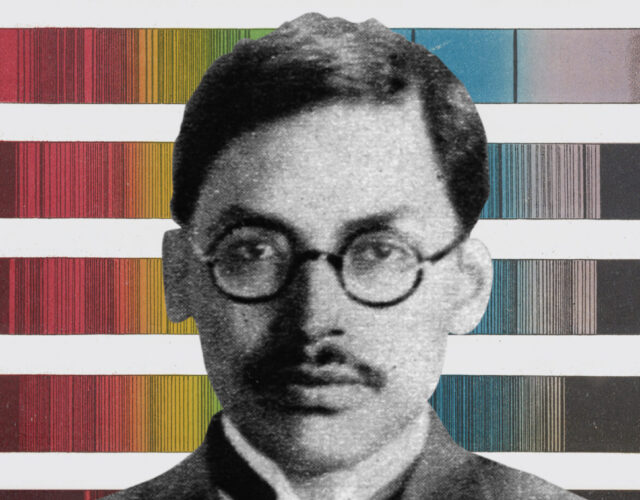Like species, sciences evolve. In particular, they often shift from purely descriptive fields to more precise and predictive undertakings. In the 1800s, for example, the passive taxonomies of Linnaeus gave way to the natural selection of Darwin. The scientists who bring about such revolutions usually enjoy widespread fame. Usually. But the Darwin of astronomy—a poor polymath from what’s now Bangladesh—remains virtually unknown in the West today.
Meghnad Saha was born into a low-caste family in 1893, the fifth of eight children. After an older brother flunked high school, the father declared schooling a waste of money and put Saha to work in the family grocery. A kindly local doctor who recognized Saha’s talent intervened and enrolled the boy in middle school. When monsoons flooded his village, Saha rowed a boat to class. Because of his caste many students refused to eat in the same room with him. But at least he got a second chance at school.
And then he promptly blew it. In the early 1900s the British government proposed splitting Saha’s Bengali state into Hindu and Muslim halves, a controversial move. Protests erupted nationwide, and when the local governor visited Saha’s school, the barefoot boy joined the denunciations. School administrators, embarrassed, expelled him and several others.
But again someone took pity. Another school’s principal, looking for charity cases, enrolled Saha, who made the most of this third chance. After scoring top marks in astronomy and chemistry in high school, he went to college and studied an eclectic mix of fields—thermodynamics, quantum physics, German. Surprisingly, the German helped his career as much as anything. He initially made a name for himself as a young professor by translating some of Einstein’s seminal papers on relativity into English. And in 1919, as World War I ended and German journals began trickling into India again, Saha read a paper that changed his life.
It involved thermal ionization, the stripping away of electrons as atoms heat up. The paper seemed superficial, and Saha knew he could push the research further. Specifically, he could combine his knowledge of chemistry with quantum physics to determine the exact temperatures at which atoms of different elements lose electrons. And owing to his background in astronomy he realized that the work could in turn answer a vexing question about stars.
All stars produce a spectrum—a barcode-like pattern of thin, black lines that appear when starlight filters through a prism. Since the mid-1800s astronomers had been classifying stars into Linnaeus-like taxonomies based on similar spectra. Embarrassingly, though, no one knew what those groupings meant. Why did different categories of stars exist?
Saha realized that the answer involved chemistry. Electrons within atoms absorb light of specific frequencies, creating the dark bands in stellar spectra. And Saha determined that as rising temperatures strip more and more electrons out of atoms, the location and number of the dark bands change. In other words, different temperatures lead to different patterns of bands. So when astronomers were sorting stars into different groups by spectrum, they were really sorting them by temperature. What’s more, after Saha provided equations to describe thermal ionization, other astronomers could determine related information, such as the precise temperatures of stars and the abundance of elements inside them. Thanks to Saha, humankind understood what stars were—fiery balls of hydrogen—for the very first time.
Sadly, though, because India lacked modern astronomical equip-ment, Saha had no opportunity to confirm his theories with stellar data and therefore lost credit for several important discoveries. Instead, he drifted into other areas of science and eventually returned to the con-frontational politics of his youth. This transition was under way even before he made his major scientific discoveries. In 1915 he got tangled up in a scheme to smuggle guns into India to attack British troops. And during India’s push for independence he grew increasingly impatient with the nonviolent activism of Mahatma Gandhi. Saha and Gandhi clashed over several issues, especially Gandhi’s hostility toward science, which he viewed as an imperialist institution. Saha defended science as the key to pulling people out of poverty, and on this conviction he won a seat in India’s parliament in 1952, where he took on projects as varied as nuclear power and calendar reform.
But it’s astronomy where Saha left his biggest mark. Before his contribution most astronomers were content to merely catalogue stars. After his contribution astronomy became a genuine, predictive science. Someone once quipped that all of Western philosophy consists of little more than “footnotes to Plato.” By the same token much of modern astrophysics and astrochemistry has been the working out of the ideas of a rebellious young man named Meghnad Saha.




